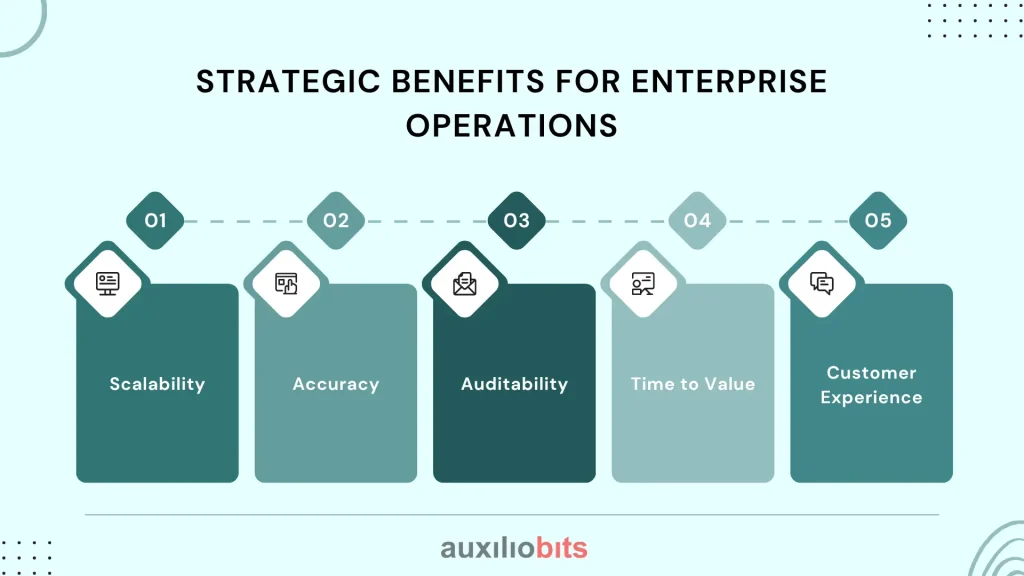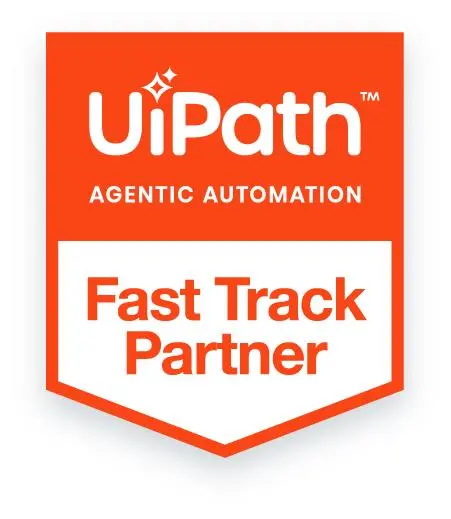
Key Takeaways
- Unlike traditional task-based automation, HyperAutomation orchestrates entire workflows by integrating RPA, AI/ML, IDP, NLP, and Agentic AI. It enables enterprises to move beyond siloed automation into an enterprise-wide operating model transformation.
- The real differentiator of HyperAutomation is not just the tools, but how they are orchestrated. Intelligent coordination across processes, systems, and teams makes automation adaptive, scalable, and enterprise-ready.
- Use cases like claims processing illustrate HyperAutomation’s value—by reducing delays, eliminating manual errors, and enhancing compliance. Technologies like IDP, RPA, and AI agents automate data-heavy and decision-based tasks end-to-end.
- Executives should measure success using KPIs like cycle time, first-time accuracy, automation coverage, and exception handling rate—not just cost savings or bot counts. These reflect long-term operational gains.
- The next frontier of HyperAutomation includes autonomous agents, inter-agent protocols, and self-repairing workflows. These innovations blur the line between operations and intelligence, creating dynamic, responsive enterprises.
HyperAutomation represents a shift in how enterprises approach process efficiency. Rather than applying automation tactically to individual tasks, it introduces a strategic framework to optimize entire workflows from end to end. This is especially relevant in today’s post-digital era, where companies face increasing complexity, regulatory demands, and customer expectations for speed and transparency.
Claims processing is one domain where HyperAutomation has delivered substantial value. By combining technologies such as intelligent document processing, RPA, and AI, enterprises have achieved faster turnaround times, lower error rates, and higher customer satisfaction. However, the strategic importance of HyperAutomation extends far beyond any single use case—it redefines how value is created across the entire enterprise.
Also read: HyperAutomation vs. Traditional Automation: Technical Architecture Comparison
What Is HyperAutomation?
HyperAutomation is not a single technology but a coordinated ecosystem of tools and capabilities that work together to automate complex business processes. It integrates:
- Robotic Process Automation (RPA) to handle repetitive, rules-based tasks
- AI/ML to introduce decision-making and adaptability
- Natural Language Processing (NLP) and IDP to process unstructured data
- Process mining to identify bottlenecks and inefficiencies
- Low-code/no-code platforms to accelerate development
- Agentic AI systems that can operate autonomously within enterprise ecosystems
The key differentiator is orchestration. HyperAutomation connects disparate systems, roles, and data into a cohesive, intelligent process. It shifts automation from a backend efficiency project to a business value driver.
Why HyperAutomation Is Gaining Momentum?
Several converging trends have made HyperAutomation a priority for enterprise leaders:
- Digital saturation: Many organizations have already digitized their data and workflows. The next step is automating the actions that flow from them.
- Data deluge: As unstructured data increases, manual interpretation becomes a bottleneck.
- Workforce shifts: Rising labor costs and the prevalence of remote work have made workforce augmentation a necessity.
- Competitive pressure: Faster, leaner rivals are forcing legacy enterprises to rethink operational speed and responsiveness.
Traditional automation often fails under real-world conditions where exceptions, variations, or contextual factors are present. HyperAutomation solves this by being dynamic, intelligent, and context-aware. It doesn’t just “do” faster—it “thinks” better.
Core Technologies That Power It
HyperAutomation requires a layered tech stack. Each component plays a specific role:
- RPA: Still foundational, RPA automates basic tasks like data entry, validation, and transfer.
- IDP: Intelligent Document Processing enables systems to extract and classify data from forms, emails, invoices, etc.
- Machine Learning: Models help systems make decisions, detect fraud, or recommend future actions.
- NLP: Useful for understanding human-written content and handling customer queries.
- Process Mining: Provides transparency into how processes run, not how we think they run.
- Agentic AI: This new class of intelligent agents operates autonomously, planning actions, adapting to changes, and collaborating with other agents.
Together, these tools make HyperAutomation adaptive and resilient. They enable businesses to respond in real-time while reducing their dependency on human intervention.
Strategic Benefits for Enterprise Operations
HyperAutomation changes the enterprise operating model:

- Scalability: You can replicate automated workflows across business units without scaling headcount.
- Accuracy: Automation removes human error in repetitive tasks.
- Auditability: Each step is traceable, supporting compliance and regulatory needs.
- Time to Value: Projects move faster, and ROI appears sooner.
- Customer Experience: Reducing wait times and providing consistent responses increases customer satisfaction.
One of the strongest signals of strategic impact is when automation shifts from IT-led initiatives to board-level priorities. When HyperAutomation is embedded into core business objectives—such as accelerating claims processing or reducing loan approval cycles—its actual value is realized.
Claims Processing: A High-Value Use Case
Claims processing stands out as a top candidate for HyperAutomation due to its complexity, compliance requirements, and reliance on documents. It typically includes:
- Receiving structured or semi-structured claims forms
- Verifying identity, eligibility, or coverage
- Cross-checking information with policy documents or CRM data
- Approving or flagging claims for manual review
- Notifying stakeholders and disbursing funds
Delays and manual bottlenecks frequently hinder this process. HyperAutomation transforms it by:
- Using IDP to auto-extract key fields from scanned forms
- Validating data using RPA and real-time database queries
- Employing ML to flag anomalies or predict approval likelihood
- Deploying agents that route claims, handle escalations, and communicate with customers
While claims processing isn’t the only HyperAutomation use case, it demonstrates how intelligent orchestration creates faster, more accurate outcomes.
Beyond Claims: Cross-Industry HyperAutomation Opportunities
While claims are a poster child, HyperAutomation shines across industries.
This technology suite delivers scalable value wherever there are repeatable workflows, data bottlenecks, or compliance pressures.
a. Banking and Finance
- Credit risk analysis, loan approval, and fraud detection
- Reconciliation and compliance automation
b. Healthcare
- Patient onboarding, prior authorization, and medical coding
- EHR data synchronization using AI agents
c. Manufacturing
- Vendor onboarding, quality control, predictive maintenance
- Inventory management across warehouses
d. Retail
- Dynamic pricing, customer query handling, and supply chain updates
- Sentiment analysis from reviews and social media
Key Metrics That Reflect HyperAutomation Success
Leaders evaluating HyperAutomation should look beyond the number of bots or hours saved. Strategic metrics include:
- Cycle Time: Average time to complete a process from start to finish
- First-Time Accuracy: Percentage of transactions completed without rework
- Exception Handling Rate: Percentage of issues resolved without human intervention
- Automation Coverage: Percentage of total process steps automated
- Customer Satisfaction: Especially in client-facing processes like onboarding or claims
- Operational Cost Reduction: Lower headcount needs or reduced SLA penalties
Monitoring these KPIs enables continuous improvement and justifies investment beyond pilot phases.
Getting Started: A Roadmap for Enterprise Leaders
To implement HyperAutomation at scale, enterprises should take a structured approach:
- Process Discovery: Use mining tools to identify inefficiencies and rank opportunities.
- Document Automation First: Start with IDP for fast wins in document-heavy processes.
- AI Layer Next: Add intelligence where rules break down—for decision and exception handling.
- Orchestrate with Agents: Deploy agentic systems that can plan, decide, and act autonomously.
- Govern and Monitor: Establish KPIs, governance policies, and feedback mechanisms for continuous improvement and optimization.
HyperAutomation isn’t an off-the-shelf solution. It’s an evolving capability that needs the right mix of platforms, training, and change management.
How to Choose the Right Processes for HyperAutomation?
Before investing, it’s critical to prioritize processes with the highest impact potential.
Key Criteria:
- Repetition: High-frequency, repetitive tasks are ideal starting points.
- Volume: Processes with extensive data or transaction volumes benefit most.
- Rule-based Decisioning: Processes driven by clear logic can be automated quickly.
- Data Availability: Processes with accessible structured or unstructured data are easier to automate.
- Pain or Value Points: Identify bottlenecks, SLA breaches, or compliance risks.
Examples:
| Process | Suitability Reason |
| Invoice Matching | High volume, structured data |
| Employee Onboarding | Repetitive, rule-based steps |
| Claims Intake | Multi-system coordination, time sensitivity |
| Loan Pre-Approval | Decision-heavy but rules-driven |
Starting with such processes enables organizations to achieve early ROI and establish a repeatable HyperAutomation model.
Future Outlook: Autonomy, Intelligence, and Interoperability
The future of HyperAutomation is deeply tied to the evolution of AI and autonomy. Key trends include:
- Autonomous agents that handle complex tasks like invoice reconciliation or claims negotiation end-to-end
- Inter-agent protocols that allow systems to negotiate and resolve cross-functional functions without human input
- Explainable AI that supports regulatory compliance by justifying decisions
- Multimodal understanding that combines text, voice, image, and structured data into unified automation contexts
- Self-healing workflows where agents detect and repair broken process paths in real time
As enterprises adopt these innovations, the boundary between operations and intelligence will blur, making automation a living part of the organization.
Final Thoughts
HyperAutomation is not about replacing humans; it’s about creating scalable systems that let humans focus on judgment, strategy, and innovation. When done right, it transforms operations, drives growth, and enhances the customer experience.
Enterprise leaders should treat HyperAutomation as a strategic enabler. Whether you’re looking to improve financial processing, customer onboarding, or claims management, the building blocks are the same: intelligence, orchestration, and adaptability.
The question is no longer if you should embrace HyperAutomation, but how fast you can do it at scale.








